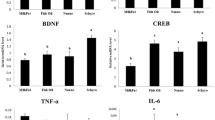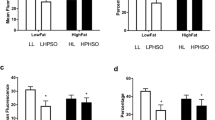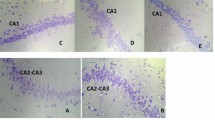Abstract
The effects of fish oil supplementation on motor disorders, memory dysfunction, and lipid peroxidation (LP) induced by typical neuroleptics were studied. Wistar rats received a suspension prepared with fish oil containing ω-3 fatty acids, water, and Tween 80 (1%) in the place of drinking water (FO group) or vehicle (C group) for 8 weeks. After 4 weeks of treatment, half of the animals of both groups were treated with haloperidol (H and FO + H groups; experiment 1), fluphenazine (F and FO + F groups; experiment 2), or vehicle (C group), administered once a week (12 mg/kg/im) for 4 weeks, maintaining the treatment with FO. Extrapyramidal motor disorders by haloperidol and fluphenazine were observed by an increase in vacuous chewing movements and catalepsy (P < 0.05). These effects were reduced by FO treatment (P < 0.05). Both neuroleptics displayed impairment in memory retention observed by latency time to find the original location of platform in water-maze task, after 4 days of training performed in the last treatment week. This effect was reduced by FO (P < 0.05) to both haloperidol and fluphenazine treatments. Haloperidol increased the LP in plasma and hippocampus, and these effects were decreased by FO treatment (P < 0.05). Fluphenazine increased the LP in plasma and substantia nigra, which were completely decreased by FO treatment (P < 0.05). The FO decreased the motor disorders, memory dysfunction, and oxidative damage typical neuroleptic-induced. Our results indicate that FO exhibits a neuroprotector role useful on diseases related to oxidative damages, and may be considered in the prevention of motor and memory side effects induced by the antipsychotic treatment.





Similar content being viewed by others
References
Abilio VC, Araujo CCS, Bergamo M, Calvente PRV, D’Almeida V, Ribeiro RA, Frussa-Filho R (2003) Vitamin E attenuates reserpine-induced oral dyskinesia and striatal oxidized glutathione/reduced glutathione ratio (GSSG/GSH) enhancement in rats. Prog Neuropsychopharmacol Biol Psychiatry 27:109–114
Andreassen OA, Jorgensen HA (2000) Neurotoxicity associated with neuroleptic-induced oral dyskinesia in rats. Implications for tardive dyskinesia? Prog Neurobiol 61:525–541
Andreassen OA, Ferrante RJ, Aamo TO, Beal MF, Jorgensen HA (2003) Oral dyskinesia and histopathological alterations in substantia nigra after long-term haloperidol treatment of old rats. Neuroscience 122:717–725
Bas O, Songur A, Sahin O, Mollaoglu H, Ozen OA, Yaman M, Eser O, Fidan H, Yahmurca M (2007) The protective effect of fish n-3 fatty acids on cerebral ischemia in rat hippocampus. Neurochem Int 50:548–554
Bazan NG (2006) The onset of brain injury and neurodegeneration triggers the synthesis of docosanoid neuroprotective signaling. Cell Mol Neurobiol 26:899–911
Bazan NG (2007) Omega-3 fatty acids, pro-inflammatory signaling and neuroprotection. Clin Nutr Metab Care 10:136–141
Benninger RJ (1983) The role of dopamine in locomotor-activity and learning. Brain Res Rev 6:173–196
Benninger RJ, Miller R (1998) Dopamine D1-like receptor and reward-related incentive learning. Neurosci Biobehav Rev 22:335–345
Black KL, Hoff JT, Radins NS, Deshmukh GD (1984) Eicosapentaenoic acid: effect on brain prostaglandins, cerebral blood flow and edema in ischemic gerbils. Stroke 15:65–69
Bürger ME, Fachinetto R, Alves A, Callegari L, Rocha JBT (2005a) Acute reserpine and subchronic haloperidol treatments change synaptosomal brain glutamate uptake and elicit orofacial dyskinesia in rats. Brain Res 1031:202–210
Bürger ME, Fachinetto R, Zeni G, Rocha JBT (2005b) Ebselen attenuates haloperidol-induced orofacial dyskinesia and oxidative stress in rat brain. Pharmacol Biochem Behav 81:608–615
Cadet JL, Lohr JB, Jeste DV (1986) Free radical and tardive dyskinesia. Trends Neurosci 9:107–108
Cadet JL, Lohr JB, Jeste DV (1987) Tardive dyskinesia and schizophrenie burnout the possible involvement of cytotoxic free radicals. In: Henn FA, DeLisi LE (eds) Handbook of schizophrenia: the neurochemistry and pharmacology of schizophrenia. Elsevier, Amsterdam, pp 425–438
Casey DE (1995) Motor and mental aspects of extrapyramidal syndromes. Int Clin Psychopharmacol 10:105–114
Choin-Kwon S, Park KA, Lee HJ, Park MS, Lee JH, Jeon SE, Choe SE, Choe MA, Park KC (2004) Temporal changes in cerebral antioxidant enzyme activities ischemia and reperfusion in a rat focal brain ischemia model: effect of dietary fish oil. Brain Res Dev Brain Res 152:11–18
Clandinin MT, Jumpsen J, Suh M (1994) Relationship between fatty acid accretion, membrane composition, and biologic functions. J Pediatr 125(suppl):S25–S32
Colpo G, Trevisol F, Teixeira AM, Fachinetto R, Pereira RP, Athayde ML, Rocha JBT, Bürger ME (2007) Ilex paraguariensis has antioxidant and attenuates haloperidol-induced orofacial dyskinesia and memory dysfunction in rats. Neurotox Res 12:1–10
Connor WE, Neuringer M, Reisbick S (1991) Essentiality of ω3 fatty acids: evidence from the primate model and implications for human nutrition. World Rev Nutr Diet 66:118–132
Coyle JT, Putfarcken P (1993) Oxidative stress, glutamate, and neurodegenerative disorders. Science 262:689–695
Creese I, Burt D, Snyder SH (1976) Dopamine receptor binding predicts clinical and pharmacological potencies of antischizophrenic drugs. Science 193:481–483
Emsley R, Niehaus DJH, Koen L, Oosthuizen PP, Turner HJ, Carey P, Van Rensburg SJ, Maritz JS, Murch H (2006) The effects of eicosapentaenoic acid in tardive dyskinesia: a randomized, placebo-controlled trial. Schizophr Res 84:112–120
Evans DR, Parikh VV, Khan MM, Coussons C, Buckley PF, Mahadik SP (2003) Red blood cell membrane essential fatty acid metabolism in early psychotic patients following antipsychotic drug treatment. Prostaglandins Leukot Essent Fatty Acids 69:393–399
Fachinetto R, Villarinho JG, Wagner C, Pereira RP, Ávila DS, Bürger ME, Calixto JB, Rocha JBT, Ferreira J (2007) Valeriana officinalis does not alter the orofacial dyskinesia induced by haloperidol in rats: role of dopamine transporter. Prog Neuropsychopharmacol Biol Psychiatry 31:1478–1486
Haag M (2003) Essential fatty acids and the brain. Can J Psychiatr 48:195–203
Halliwel B, Gutteridge JMC (1999) Free radicals in biology and medicine, 3rd edn. Oxford University Press, Oxford
Hossain S, Hashimoto M, Gamoh S, Masumura S (1999) Antioxidative effects of docosahexaenoic acid in the cerebrum versus cerebellum an Brainstem of aged hypercholesterolemic rats. J Neurochem 72:1133–1138
Izquierdo I, Izquierdo LA, Barros DM, de Souza MM, Quevedo J, Rodrigues C, Sant’anna MK, Madruga M, Medina JH (1998) Differential involvement of cortical receptor mechanisms in working, short-term and long-term memory. Behav Phamacol 9:421–427
Jenkins RR, Goldfarb A (1993) Introduction—oxidant stress, aging, and exercise. Med Sci Sports Exerc 25:210–212
Jump DB (2002) Dietary polyunsaturated fatty acids and regulation of gene transcription. Curr Opin Lipidol 13:155–164
Kane JM, Smith JM (1982) Tardive dyskinesia: prevalence and risk factors. Arch Gen Psychiatry 39:473–481
Konitsiotis S, Tsironis C, Kiostsis DN, Evangelou A (2006) Effects of N-methyl-D-aspartate receptor antagonism on neuroleptic-induced orofacial dyskinesia. Psychopharmacology 185:369–377
Levin ED, Gunne LM (1989) Chronic neuroleptic effects on spatial reversal-learning in monkeys. Psychopharmacology 97:496–500
Lohr JB (1991) Oxygen radicals and neuropsychiatric illness: some speculations. Arch Gen Psychiatry 48:1097–1106
Marchese G, Casu MA, Bartholini F, Ruiu S, Saba P, Gessa GL, Pani L (2002) Sub-chronic treatment with classical but not atypical produces morphological changes in rat nigro-striatal dopaminergic neurons directly related to ‘early onset’ vacuous chewing. Eur J Neurosci 15:1187–1196
Matsunaga M, Ohtaki H, Takaki A, Iwai Y, Yin L, Mizuguchi H, Miyake T, Usumi K, Shioda S (2003) Nucleoprotamine diet derived from salmon soft roe protects mouse hippocampal neurons from delayed cell death after transient forebrain ischemia. Neurosci Res 47:269–276
Morris R (1984) Developments of a water-maze procedure for studying spatial learning in the rat. J Neurosci Methods 11(1):47–60
Murphy HS, Ward PA (2005) Inflammation. In: Rubin E, Gorstein F, Rubin R, Schwartinng R, Strayer D (eds) Pathology: clinicopathologic foundations of medicine, 4th edn. Lippincott Williams & Wilkins, Philadelphia, PA
Naidu PS, Singh A, Kulkami SK (2003) Quercetin, a bioflavonoid attenuates haloperidol-induced orofacial dyskinesia. Neuropharmacology 44:1100–1106
Ohkawa H, Ohishi N, Yagi K (1979) Assay for lipid peroxides in animal tissues by thiobarbituric acid reaction. Anal Biochem 95:351–358
Ozyurt B, Sarsilmaz M, Akpolat N, Ozyurt H, Akyol O, Herken H, Kus I (2007) The protective effects of omega-3 fatty acids against MK-801-induced neurotoxicity in prefrontal cortex of rat. Neurochem Int 50:196–202
Parikh V, Khan MM, Mahadik SP (2003) Differential effects of antipsychotics on expression of antioxidant enzymes and membrane lipid peroxidation in rat brain. J Psychiatr Res 37:43–51
Peet M, Laugharne J, Rangarajan N, Reynolds GP (1993) Tardive dyskinesia, lipid-dyskinesia, and sustained amelioration with vitamin-E treatment. Int Clin Psychopharmacol 8:151–153
Perry G, Honda K, Liu Q, Aliev G, Siedlak SL, Harris PLR, Zhu X, Smith MA (2004) Stress and homeostatic regulation of oxidative damage in neurodegenerative disease. Free Radic Biol Med 36:59
Pillai A, Terry AV Jr, Mahadik SP (2006) Differential effects of long-term treatment with typical and atypical antipsychotics on NGF and BDNF levels in rat striatum and hippocampus. Schizophr Res 82:95–106
Pillai A, Parikh V, Terry AV Jr, Mahadik SP (2007) Long-term antipsychotic treatment and crossover studies in rats: differential effects of typical and atypical agents on the expression of antioxidant enzymes and membrane lipid peroxidation in rat brain. J Psychiatr Res 41:372–386
Ploeger GE, Spruyt BM, Cools AR (1992) Effects of haloperidol on the acquisition of a spatial-learning task. Physiol Behav 52:979–983
Ploeger GE, Spruyt BM, Cools AR (1994) Spatial localization in the Morris water maze in rats—acquisition is affected by intraaccumbens injections of the dopaminergic antagonist haloperidol. Behav Neurosci 108:927–934
Polydoro M, Schroder N, Lima MNM, Caldana F, Laranja DC, Bromberg E, Roesler R, Quevedo J, Moreira JCF, Dal-Pizzol F (2004) Haloperidol- and clozapine-induced oxidative stress in the rat brain. Pharmacol Biochem Behav 78:751–756
Rocha JBT, Santos JET, Rocha LK, Kleinpaul ER (1997) Undernutrition during suckling changes the sensitivity to haloperidol and chlorpromazine in two behavioural measures in weaning rats. Pharmacol Toxicol 80:114–123
Rogoza RM, Fairfax DF, Henry P, N-Marandi S, Khan RF, Gupta SK, Mishra RK (2004) Electron spin resonance spectroscopy reveals alpha-phenyl-N-tert-butylnitrone spin-traps free radicals in rat striatum and prevents haloperidol-induced vacuous chewing movements in the rat model of human tardive dyskinesia. Synapse 54:156–163
Rosengarten H, Quartermain D (2002) The effect of chronic treatment with typical and atypical antipsychotics on working memory and jaw movements in three- and eighteen-month-old rats. Prog Neuropsychopharmacol Biol Psychiatry 26:1047–1054
Saeedi H, Remington G, Christensen BK (2006) Impact of haloperidol, a dopamine D2 antagonist on cognition and mood. Schizophr Res 85:222–231
Sarsilmaz M, Songur A, Kus I, Ozyurt B, Gulec M, Songut S, Ilhan A, Akyol O (2003a) The regulatory role of dietary omega-3 essential fatty acids on oxidant/antioxidant balance in rat hippocampus. Neurosci Res Commun 33:114–123
Sarsilmaz M, Songur A, Ozyurt H, Kus I, Ozen OA, Ozyurt B, Sogut S, Akyol O (2003b) Potential role of dietary ϖ-3 essential fatty acids on some oxidant/antioxidant parameters in rat’s corpus striatum. Prostaglandins Leukot Essent Fatty Acids 69:253–259
Shamir E, Barak Y, Shalman I, Landon M, Zisapel N, Tarrasch R, Elizur A, Weinzman R (2001) Melatonin treatment for tardive dyskinesia—a double-blind, placebo-controlled, crossover study. Arch Gen Psychiatry 58:1049–1052
Simopoulos AP (1999) Essential fatty acids in health and chronic disease. Am J Clin Nutr 70:560S–569S
Simopoulos AP (2002) Omega-3 fatty acids in inflammation and autoimmune diseases. J Am Coll Nutr 21:495–505
Songur A, Sarsilmaz M, Sogut S, Ozyurt B, Ozyurt H, Zararsiz I, Turkoglu AO (2004) Hypothalamic superoxide dismutase, xanthine oxidase, nitric oxide, and malondialdehyde in rats fed with ω-3 fatty acids. Prog Neuropsychopharmacol Biol Psychiatry 28:693–698
Terry AV Jr, Parikh V, Gearhart DA, Pillai A, Hohanadel E, Warner S, NasrallahH HA, Mahadik SP (2006) Time dependent effects of haloperidol and ziprasidone on nerve growth factor, cholinergic neurons, and spatial learning in rats. J Pharmacol Exp Ther 318:709–724
Terry AV Jr, Gearhart DA, Warner S, Hohnadel EJ, Middlemore ML, Zhang G, Bartlett MG, Mahadik SP (2007a) Protracted effects of chronic oral haloperidol and risperidone on nerve growth factor, cholinergic neurons, and spatial reference learning in rats. Neuroscience 150:413–424
Terry AV Jr, Gearhart DA, Warner SE, Zhang G, Bartlett MG, Middlemore ML, Beck WD Jr, Mahadik SP, Waller JL (2007b) Oral haloperidol or risperidone treatment in rats: temporal effects on nerve growth factor receptors, cholinergic neurons, and memory performance. Neuroscience 146:1316–1332
Wainwright PE (2002) Dietary essential fatty acids and brain function: a development perspective on mechanisms. Proc Nutr Soc 61:61–69
Wainwright PE, Xing HC, Mutsaers L, McCutcheon D, Kyle D (1997) Arachidonic acid offsets the effects on mouse brain and behavior of a diet with a low (n-6)/(n-3) ratio and very high levels of docosahexaenoic acid. J Nutr 127:183
Yehuda S (1989) Behavioral effects of dietary fats. In: Chandra RK (ed) Health effects of fish and fish oils. ARTS, St. John’s, NF, Canada, pp 327–335
Yehuda S, Carasso RL (1987) Effects of dietary fats on learning, pain threshold, thermoregulation and motor activity in rats: Interaction with the length of feeding period. Int J Neurosci 32:919–925
Yehuda S, Rabinovitz S, Mostofsky DI (2005) Essential fatty acids and stress. In: Yehuda S, Mostofsky DI (eds) Nutrition, stress and medical disorders. Humana Press, Totowa, NJ, pp 99–100
Zararsiz I, Kus I, Akpolat N, Songur A, Ogeturk M, Sarsilmaz M (2006) Protective effects of omega-3 essential fatty acids against formaldehyde-induced neuronal damage in prefrontal cortex os rats. Cell Biochem Funct 24:237–244
Author information
Authors and Affiliations
Corresponding author
Rights and permissions
About this article
Cite this article
Barcelos, R.C.S., Benvegnú, D.M., Boufleur, N. et al. Effects of ω-3 Essential Fatty Acids (ω-3 EFAs) on Motor Disorders and Memory Dysfunction Typical Neuroleptic-induced: Behavioral and Biochemical Parameter. Neurotox Res 17, 228–237 (2010). https://doi.org/10.1007/s12640-009-9095-0
Received:
Revised:
Accepted:
Published:
Issue Date:
DOI: https://doi.org/10.1007/s12640-009-9095-0




